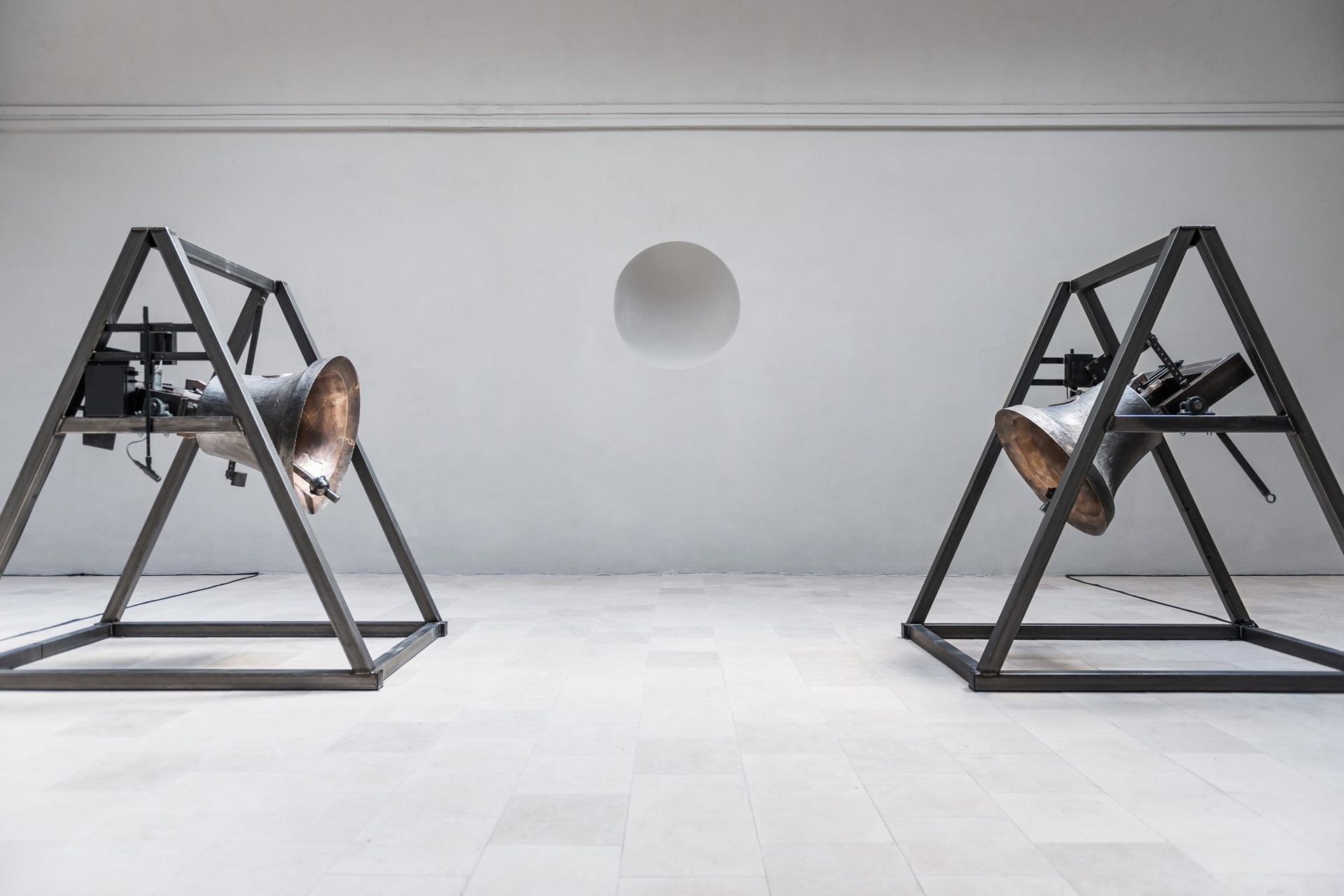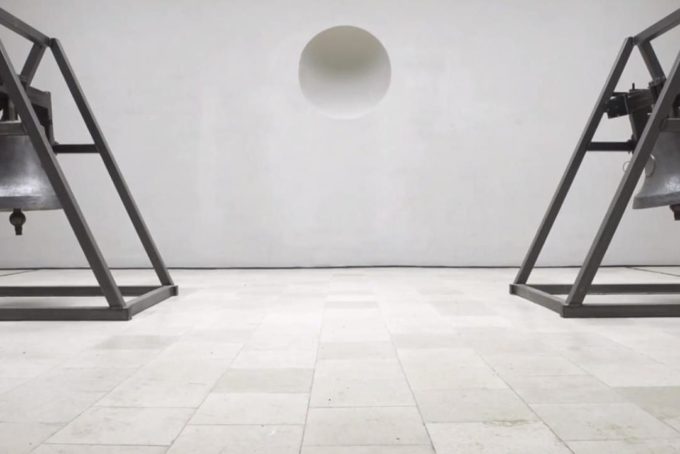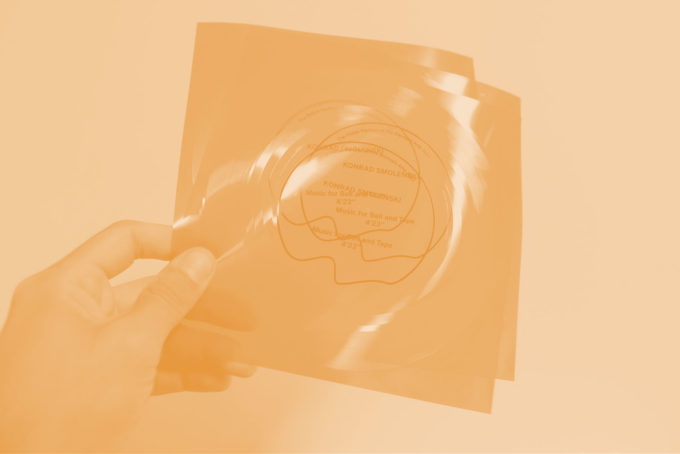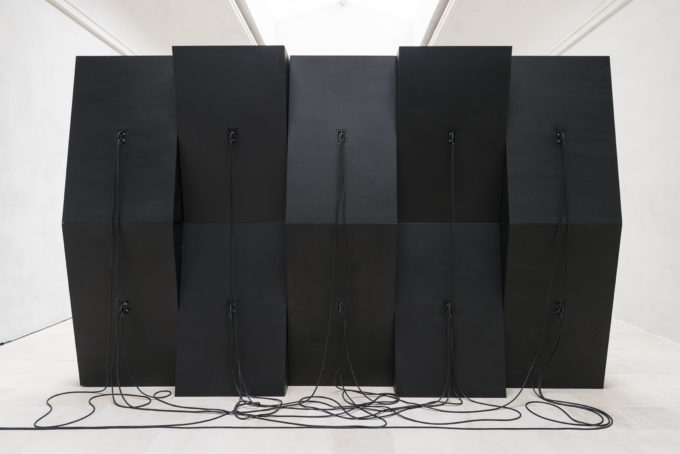
Everything Was Forever, Until It Was No More
Konrad Smoleński
The two hand-made bronze bells which form the core of Konrad Smoleński’s installation at the Polish Pavilion successfully convey a somewhat crude and “primitive” character of a work that alludes to the traditional craft of bell-founding. The bells located in the central part of the building, along with the rows of broadband speakers echoing them and the two opposing walls of metal cases, serve as an example of a model stereophonic system. Although the form of the individual constituents seems familiar, the interaction between them in this relatively small space is quite startling. What seems especially out of place in this arrangement is the idiophones which are normally placed well above the line of vision. Moreover, the purpose of the two hundred small metal doors is open to interpretation — their size and appearance are quite universal and may be associated with a number of different public spaces and the respective functions that correspond to them. Each of the constituents of this visual and aural arrangement plays an equal part. In Smoleński’s composition the sound of a traditional instrument is first recorded in real time and then processed, delayed and retransmitted. This is alternated with a monotonous drone from the enormous speakers, and finally the sound reverberates through the metal structures which are integrated with the architecture of the pavilion.
Previously shown in Venice, the sound sculpture is based primarily on the manipulation of the tolling of a bell — an ancient instrument which has for centuries set the rhythm of our earthly and “eternal” lives. While transforming this familiar sound, Smoleński changes its meaning: a sound that evokes a variety of associations is now given an abstract frequency which seems devoid of connotations. Not only does the artist free the signal from its source, but he also resorts to the use of delay and reverberation. The accumulation of acoustic waves provides the broadcast sound with a weight which has a direct impact on all the subjects and objects around the installation. It appears that the acoustic signal can move the molecules of both animate and inanimate objects with an equal force.
The installation in the Polish Pavilion is a continuation of more than a decade of explorations carried out by a visual artist with a keen interest in sound. Smoleński’s works combine punk rock aesthetics with the precision and elegance typical of minimalism. The artist uses both traditional and self-constructed sound objects to examine the flow of energy and its interaction with the audience. By exploring the possibilities of electricity, sound waves and PA systems, the artist manipulates the meanings we usually attribute to objects which are typically used in rock culture.
These artistic endeavors and the way Smoleński uses his “instruments” in Everything Was Forever, Until It Was No More bring to mind the illusory nature of time, as proclaimed by Julian Barbour. This British theoretical physicist undermines the significance of time while conjuring up his vision of a timeless universe, where one of the key categories is the present perceived as a three-dimensional snapshot, and where the chronological ordering of events is a result of nothing more than our memory of individual “Nows.” Therefore, time, according to Barbour, is but a sensation of temporality, enhanced by what he calls “time capsules”, or records of what we believe to have existed in the past.
Aside from Barbour’s hypotheses, our analysis of the artist’s experiments, including those with the sound of a traditional instrument, is based on a number of other scientific and literary theories, all expressing the inaccuracy or exhaustion of the idea of time. These include science-fiction stories, dissertations on experiments with sound and aural illusions, and studies on such museum concepts as the Encyclopedic Palace. An echo of the Venetian installation used as a tool for accumulating energy can also be found in The Voices of Time by J. G. Ballard which offers an entropic vision of the “last man on Earth” collecting so-called terminal documents. The aforementioned compositional tools used by Smoleński are also typical for Samuel Beckett for whom the notion of time is one of the key issues, both in terms of text and plot structure. Thus, repetition, change and non-accomplishment, primary features of Beckett’s work, are characteristics that also to be found in Smoleński’s works. Both in Beckett’s plays and in Everything Was Forever, Until It Was No More, time is regarded as a persistence whose intervals and dimensions, generally known as the past, present and future, merge into one with time itself becoming, in the words of the playwright, “a monster that both condemns and redeems.”
The full version of the exhibition’s title taken from the book of Alexei Yurchak: Everything Was Forever, Until It Was No More. The Last Soviet Generation (Princeton University Press, 2005).
- YEAR2013
- CATEGORY Biennale Arte
- EDITION55
- DATES01.06 – 24.11
- COMMISSIONERHanna Wróblewska
- CURATORDaniel Muzyczuk & Agnieszka Pindera
Artist
Konrad Smoleński (1977) graduated from the Poznań Academy of Fine Arts (2002). He has shown his work in numerous exhibitions at the following venues, among others: Ludwig Museum, Budapest; Pinchuk Art Center, Kyiv; Museum Morsbroich, Leverkusen; Waterside Contemporary, London; Offen auf AEG, Nuremberg; Palais de Tokyo, Paris; and Zachęta — National Gallery of Art, Warsaw. Holder of the Polish Ministry of Culture and National Heritage fellowship (2000). Winner of the Deutsche Bank Foundation Award — Views 2011. He lives and works in Warsaw (PL) and Bern (CH).
www.konradsmolenski.com
The work at the Polish Pavilion was a logical continuation of the artist’s research into flows and eruptions of energy. Thus, his previous pieces and their qualities can work as a context in analyzing Everything Was Forever, Until It Was No More.
BNNT (2007–ongoing) are audio performances by Konrad Smoleński and Daniel Szwed, which are held in open public spaces of cities, or in the institutionalized spaces of galleries and festival venues. The band members travel in a van which serves them as an improvised stage where they perform in balaclavas or masks. Each performance involves a sonic attack with the use of a string instrument modeled on the Tomahawk missile (Konrad Smoleński) and a drum set (Daniel Szwed). This is an interdisciplinary project involving both public performance — so-called sound bombing — and a publishing activity, which the duo have run for a few years now.
It’s Bigger Than Me (2012) is a sculpture, a monumental figure, albeit minimalistic in shape, resembling a speaker casing or a simplified head which through vibration becomes at the same time a source of sound. Inside there are frequency generators producing the physical sensation of signal reception, which is especially strong from a close distance. Consisting mainly of low tones, the composition was made with the aid of a program used by sound engineers to check the acoustics of a concert hall. Such low tones can carry over long distances. What you hear is a monotonous drone of the type that could be sent out from a distant factory. Here several tracks are superimposed on one another; as a result the sound is at some points pleasantly harmonious and at others starkly dissonant.
Excerpts from the curators' essay
Daniel Muzyczuk and Agnieszka Pindera. Everything Was Forever, Until It Was No More
[…]
Artists and writers, from Robert Smithson through J. G. Ballard to Thomas Pynchon, have long been inspired by both physical theories and science fiction literature in their creation of works that attempt to describe a universe whose energy is being downgraded. In his description of this complex phenomenon, Smithson used terminology borrowed from the father of cybernetics:
Norbert Wiener in The Human Use of Human Beings postulates that entropy is the devil, but unlike the Christian devil which is simply a rational devil with a very simple morality of good and evil, the entropic devil is more Manichean in that you really can’t tell the good from the bad. There’s no clear cut distinction. And I think at one point Weiner also refers to modern art as a kind of Niagara of entropy. In information theory you have another kind of entropy. The more information you have, the higher degree of entropy, so that one piece of information tends to cancel out the other. [Alison Skye, “Entropy Made Visible” (interview with Smithson), in Robert Smithson: The Collected Writings, ed. Jack D. Flam (Berkeley: University of California Press, 1996), pp. 301–302.]
Also Gravity’s Rainbow (1973) by Pynchon, while clad in the costume of a tale dating from the end of World War II and the period immediately after the war, is in fact a story about entropy and its consequences. And then, after more than three decades of shunning the notion of time, the writer once again decided to address the theme in Against the Day (2006). The characters populating this novel set at the turn of the 20th century find themselves in a reality which is quite independent from time moving in one direction only. They explore different possibilities of defying time and draw a distinction between human time and deep (geological) time. The presence of entropy in Pynchon and Smithson’s works can be explained by treating them as a diagnosis of the collapse of a certain understanding of modernity, which Nick Land summarizes thus:
“Modernity discovers irreversible time — conceived as a progressive enlightenment tracking capital concentration — integrating it into nineteenth-century science as entropy production, and as its inverse (evolution).” [Nick Land, “Cybergothic,” in idem, Fanged Noumena. Collected Writings 1987–2007 (Falmouth: Urbanomic, 2011), p. 351.]
Both critics of late modernity observe the consequences of the disintegration and energy loss which has superseded enlightenment. Energy Hunters (2011) by Konrad Smoleński, a film packed into an enormous structure resembling a giant speaker, evokes a similar atmosphere. Some time ago, one of the present authors attempting to describe the work in the context of the artist’s overall approach wrote the following passage:
Destruction caused by electrical discharges, short circuits, distortions, fire and omnipresent endism are just some of his chosen means of expression. He sells us tickets for a trip to a world a moment before explosion, where danger can be implied only from a low drone that inevitably causes a virtually physiological reaction and evokes anxiety. Or these are states of gradual energetic decline, entropy, characteristic for any complex system. He tells us, “Watch this and you’ll see electricity flowing.” And yet his installation is deceptive. The episodes of the film are woven together by the presence of the balaclava-clad members of the band Foot Village who, however, instead of a regular energetic stage show deliver what looks like a rehearsal, using their instruments to demonstrate the suspension of power without outlet. At the same time, they perform destruction, but not of a rock concert-style. The narrative is interrupted several times by blackness, devouring the sources of sound in moments of extreme chaos and sonic pulp. Can we see blackness as destruction leading to a sense of completeness? I doubt it, but my reception of this work is accompanied by a feeling that someone committing suicide must experience a moment before jumping from the bridge. A delicate tingling in the feet, the word “the end” appearing somewhere under the eyelids. Or perhaps this is just about being blinded by the sun, which can also bring about fever, visions and hallucinations (without the use of cacti or other substances)? [Daniel Muzyczuk “Views 2011,” in Views. Edition V, ed. Daniel Muzyczuk (Warsaw: Zachęta National Gallery of Art, 2011), pp. 51–53.]



